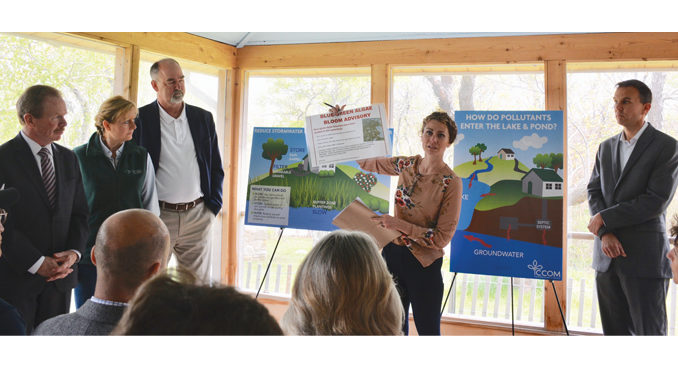
by Patria Baradi Pacis
On Monday, May 14, Concerned Citizens of Montauk (CCOM) gave a talk at the Fort Pond House on harmful blue-green algae (cyanobacteria) that was detected in Fort Pond, during the summers of 2015 and 2017 which produced toxins that was found detrimental to the health of humans, pets and aquatic life. There was so much toxin bloom last summer that the yearly Mightyman Montauk Triathlon had to be canceled. Some dogs were reported to get sick after ingesting the polluted water.
During the talk, CCOM’s President Laura Tooman announced that beginning this June, water samples will be taken from Fort Pond every week and brought to Gobler Lab, headed by Dr. Christopher Gobler to be analyzed. Results will be posted, according to CCOM’s press release, to the New York State Department of Environmental Conservation’s Harmful Algal Bloom (HAB) Notification website and circulated along with CCOM’s testing results. “Gobler’s results will be analyzed by the New York State Department of Health and Suffolk County Department of Health Services to determine if and when swimming health or swimming advisories should be issued.”
Stony Brook University Professor and Director of New York State’s Center for Clean Water Technology, Dr. Christopher Gobler, gave a lot of credit to CCOM for taking a proactive approach and was happy to be partnering with them to help in finding solutions to the problem. Deputy Suffolk County Executive, Peter Scully, advised the group that we need more data to obtain grants from the county. E. H. Town Supervisor Peter Van Scoyoc, encouraged house owners to update their cess pools and outdated septic tanks by offering financial assistance. Town Councilman, David Lys who grew up in Montauk all his life, hopes to lower the nitrogen from the pond since nitrogen is food for algae.
Colorful posters were on display to educate individuals on how to reduce stormwater runoff to prevent pollutants from entering the pond. 1) Use native plants to create rain gardens and buffer zones. 2) Store and collect water in rain barrels to use during droughts and 3) reduce paved/impervious surfaces on your property.
This reporter asked the panel if Montauk’s water is safe to drink after hearing about Wainscott’s well water contaminations. The answer was “Yes” since our water comes from ground water aquifers that are frequently tested. “If you have a well,” Mr. Scoyoc advised me to “have it tested.” After the talk, I thanked CCOM and the VIP’s for addressing Montauk’s dilemma. Hopefully, we can get Fort Pond clean and healthy once more so that we can enjoy swimming, paddling and kayaking again.
CCOM’s goal is to preserve and protect the unique ecology of Montauk through education, advocacy and grassroots citizen action. For more info or if you want to volunteer your time or donate, kindly check their website www.preservemontauk.org.

